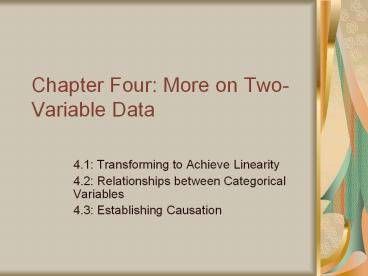Chapter Four: More on Two-Variable Data PowerPoint PPT Presentation
1 / 10
Title: Chapter Four: More on Two-Variable Data
1
Chapter Four More on Two-Variable Data
- 4.1 Transforming to Achieve Linearity
- 4.2 Relationships between Categorical Variables
- 4.3 Establishing Causation
2
4.1 Transforming to Achieve Linearity
- Two specific types of nonlinear growth
- An exponential function has the form y abx.
- A power function follows the form y axb.
- To test if data follows linear or nonlinear
growth, check the difference between consecutive
y-values - There is linear growth if a fixed amount is added
to y for each increase in x. - The data is exponential if the common ratio,
found using yn/yn-1, is equal between consecutive
y-values. - If the common ratio gt 1, exponential growth is
occurring, and if the common ratio lt 1,
exponential decay is occurring. - Both exponential and power function equations use
essentially the same format - Transform into linear forms, use the linear
regression to find the LSRL, and take an inverse
transformation to get a curve modeling the
original data.
3
Exponential Functions
- Once you know that the data represents an
exponential function, plug the data into your
calculator. - Create a separate list for log(y) and use that
information to derive the LSRL - log y a bx
- To determine the linearity, check the correlation
and residual plot. - The residual plot is the graph of x vs RESID. A
pattern would indicate that a linear relationship
is not the best model for the association of the
variables. - Raise 10 to both sides of the equation (ie, take
the inverse of log), and simplify - 10log y 10abx
- y (10a)(10bx)
- This gives you the exponential form to fit the
original data. - Graph the original scatterplot, and overlay with
this equation as y 10(RegEQ)
4
Example
- Electronic Funds Transfer (EFT) machines first
appeared in the 1980s, and their use increased
drastically in the years following. Look at the
table on the following slide, and determine if
the transactions grew exponentially. Then obtain
the LSRL equation, and from that obtain the
equation for the model.
5
Table
Year Number of transactions (millions)
1985 3,579
1990 5,942
1991 6,642
1992 7,537
1993 8,135
1994 8,958
1995 10,464
1996 11,830
6
Steps
- 1Graph initial data (x vs. y)
- 2Test for exponential growth (yn/yn-1)
- 3Perform linear regression on initial data
- 4Look at residual plot of initial data and
consider r and r2 - 5Transform y to log y
- 6Graph transformed data (x vs. log y)
- 7Perform linear regression on transformed data
- 8Look at residual plot, r, and r2
- 9Perform inverse transformation of linear
equation to arrive at exponential model - 10Graph initial date with exponential model
7
Results
- log y -.3481 .0459x where y is the predicted
number of transactions in millions and x is the
year since 1900 - r2 .9979, r .9990
- This tells us that our linear model above is a
good fit for the transformed date and that our
exponential model will be a good fit for the
initial data. In particular, we can see that
99.79 of the variation in the log of
transactions in millions can be explained by the
linear relationship with the year. - y (10-.3481)(10.0459x)
8
Power Functions
- Begin with the form y axb.
- Take the logarithm of both sides to obtain log y
(log axb), and simplify - log y log a (b log x)
- This is a form of a linear equation, so the
least-squares regression can be derived from it,
with log x as the horizontal variable and log y
as the vertical variable. - Further simplify the equation to obtain
- log y log a log xb
- To return to the original form, perform inverse
transformation by raising 10 to each side of the
equation, and simplify - 10log y 10log a log xb
- 10log y 10log a log xb
- y (10log a)(10log xb)
- (10log a)(10log x)b
- (10log a)(xb)
- axb
9
Example
- Using the following table for Olympic
weightlifting records, determine if the data
shows exponential growth or power regression, and
determine the correlation of the LSRL. Then plot
the residuals and transformed points, and find a
new equation of best fit for the original
scatterplot.
10
Table
Weight Class Limit Record Weight Lifted
119 633
130 678
141 739
154 787
167.5 809
183 864
200.5 886
218 926
238 948

